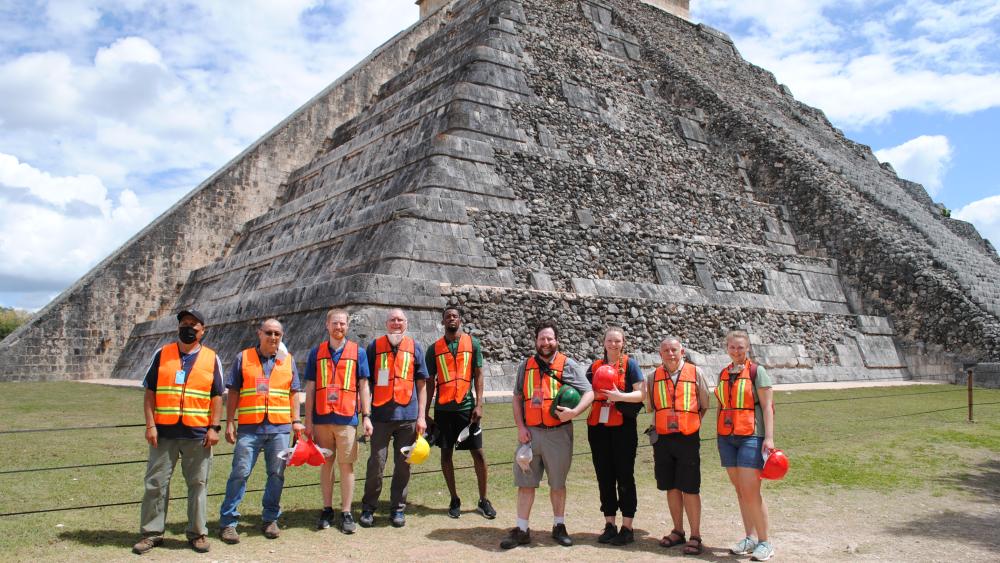Physics Professor Visits Mayan Pyramid That is Focus of Student Research Project

Efforts to explore beyond the stone walls of a famous Mayan pyramid are moving forward as part of a multi-year partnership involving physics students from Dominican University.
Over spring break in March, physics professor Joseph Sagerer made the first site visit to El Castillo, the largest pyramid in Chichen Itza, an ancient Mayan city in Mexico’s Yucatan Peninsula. During the visit, drone photography and LiDAR (Light Detection and Ranging) technology were used to scan and map the 100-foot tall, four-sided structure, which was built between the 8th and 12th centuries to honor the feathered serpent deity Kukulcan.
The scans — including images of an interior stairway leading to sculptures of a red jaguar with jade eyes and a reclining Mayan figure holding a sacrificial tray that were excavated in the 1930s — will aid in the creation of a 3D computerized model of the pyramid. The model, in turn, will be used in simulation exercises as students study how muons — particles from space that are similar to electrons — can help archeologists identify potential tunnels, voids or even inner rooms inside the pyramid without performing invasive or damaging excavations.
It was Sagerer’s first visit to the iconic pyramid, which is the focus of the Non-invasive Archaeometry Using Muons (NAUM) project, a four-year partnership between Dominican University, Chicago State University, Fermilab, Autonomous University of Mexico and the National Institute of Anthropology and History in Mexico. The project began more than a year ago and is funded through a National Science Foundation grant.
“When you get over the shock (of how large it is) and you look around, you appreciate that this is at least 1,000 years old and it’s amazing it’s still there,” Sagerer said of seeing El Castillo — also known as the Temple of Kukulcan — up close for the first time in March. “It’s part of human heritage. It’s wonderful.”
The aim of the NAUM project is to design and build a functional muon detector for use at El Castillo. Because muons can travel through material that is not very dense, more muons would be detected in areas where voids might exist behind walls.
“Essentially, the detector will give us information on locations where there is empty space (inside the pyramid),” explained student Michael Guaderrama, who is involved in the NAUM project. “The detector will distinguish where material is and where empty space may be. If we see a location which a large empty space is (detected), we can assume there is a chamber or a void or a tunnel.”
Low-resolution images can be reconstructed through the detector, Sagerer explained.
“By building up images from multiple directions, you can start to see in three dimensions where the empty spaces are,” he said.
If something of interest is detected or seen in the images, it will be up to archeologists to determine whether further exploration is warranted.
The muon detector itself will be built by Chicago State University. Completion is anticipated at the end of summer 2023, Sagerer said. Then, with the detector up and running, it will be placed around the pyramid, giving Dominican students the chance to analyze the data that comes back.
“I don’t get my hopes up that we’ll find something amazing,” Sagerer acknowledged. “I just want to prove that the technique works and that our students can accomplish this. These are all undergraduate students and they are learning as they go on how all this stuff works and how to put it together.
“If we don’t find anything new, that’s OK because we will still have learned a lot of information,” he added.
Guaderrama noted that there are many mysteries still hiding within El Castillo, which was built over an older pyramid that housed the statue of the jaguar and Mayan figure, which is known as a Chac Mool. Evidence of a third pyramid within the structure has also been uncovered.
“Just being able to find something to convince (archaeologists) to explore more would be great,” Guaderrama said.
Due to COVID-19 restrictions at the time, Sagerer said he was unable to bring a student to the pyramid over spring break, but would like to do so on a return trip this summer as part of ongoing work to get the site ready for the muon detector. This includes establishing reliable internet access and electricity inside the pyramid’s interior tunnel.